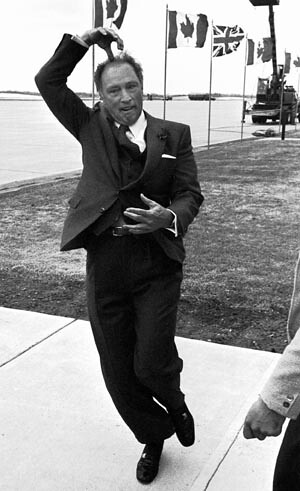
Derrick Lovell, my colleague and political scientist in-training, recently wrote a very insightful piece about how we’ve allowed our cities to forget our history. I decided to share it with you:
A couple months ago, I was reading this biography of Pierre Elliot Trudeau for a Canadian Studies class at university. Like most biographies, it began by giving a little background information – some basic facts about Trudeau’s early life. While scanning over the first few pages, I learned that I in fact live about 2 blocks from Trudeau’s early childhood home.
Learning this made me think back to a family road trip through the American Midwest in 2003. We happened to pass through the town of Abilene, Kansas, which also happens to be the childhood home of former US president Dwight D. Eisenhower. This small town of about 6500 people not only made it known that he had grown up there, but had an entire compound complete with meditation tomb site erected in his honour.
Now, I’m not saying that I think that we should dedicate oodles of tax dollars to building massive memorials to our former Prime Ministers but I do think that the basis of a strong political culture is education – a simple plaque or information panel would do. People are always complaining that Canadian politics are not as interesting as the political happenings south of the border, but I really think that, half the time, these people just don’t know the history of how Canada’s political system has evolved. Love them or hate them, our elected officials are not always boring, and I think we owe it to the Canadian population to make sure those who have shaped Canada are not forgotten.
My question for you is:
When did cities stop being monuments to the triumphs of man?
Crossposted from Apathy is Boring

4 comments
He did the same pose to me 26 years ago!!!
It was during the Quebec 84 festivities. I was working as a guide (my first real job) and I was manning a kiosk near the stairs leading up to the press room. The PM and his entourage went up to do some interviews but, shortly thereafter, Trudeau came down by himself. I grabbed my Yashika FX-D and called out “Un p’tit sourire Monsieur Trudeau”. He pulled out his tongue and struck this ridiculous pose. I was so flabbergasted that I just stood there like an idiot and never pressed the shutter.
As he walked by me he whispered: “Ca marche a tout les coups” (Works every time).
Maybe not every time.
I’d definitely be interested in plaques on buildings with historical significance, simple where appropriate “PET lived here” and historical information where possible. In London (UK), you’ll walk around and spot the blue plaques on buildings everywhere — Chopin lived here, George Orwell lived here — enticing little tidbits of history.
Quebec City does that. It’s fun to be ambling down a street and learn that H.P. Lovecraft stayed in particular building there while in town.
“When did cities stop being monuments to the triumphs of man?”
When they started being monuments to corporate brands? A defining aspect of most cities is the predominance of skylines built and defined by private corporations, from the beginning of the skyscraper era, with certain buildings becoming the icons of their cities. It’s only become more so over time. e.g.: San Francisco: Transamerica Pyramid. NYC: Woolworth Building early on, Chrysler Building, etc. Toronto: CN Tower. Kuala Lumpur: Petronas Towers. Here we have some defining skyline landmarks that aren’t corporate (the Oratory, although one can view the Church as the original and ultimate corporation) but otherwise… We’ve come to accept it as normal, but there was a time when commerce didn’t overwhelmingly define the face of cities, but was merely one element.
And it extends to the street: most of what you see in the way of information-conveying façades or whatnot is commerce-related.
There’s always some government zone of whatever size – economic power not being the only power to demand its space – but rarely does it dominate in any city (Stalinist or fascist glorious leader cults excepted.) Here and in other cosmopolitan places, the arts and education get some notable visual space, too (Place des Arts, museums, the phallic U de M tower standing in counterpoint to the mammary Oratory, as a Québecoise friend of mine once put it), but there are many cities where they’re hardly present to the public eye.
And history? You’d think it would be a priority for local governments as well as regional and national, but their attention seems to be too often on what they can do to bend over for corporations (the Griffintown mess, etc.); thus, preserving the memory and historical minutiae of communities and their notable individuals, even national ones like Trudeau, is left to non-official, often poorly-funded citizens’ groups. There’s no profit in it. (Or is there?)